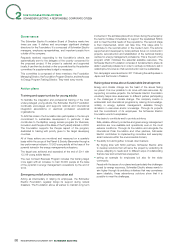APC 2011 Annual Report Download - page 80
Download and view the complete annual report
Please find page 80 of the 2011 APC annual report below. You can navigate through the pages in the report by either clicking on the pages listed below, or by using the keyword search tool below to find specific information within the annual report.
REGISTRATION DOCUMENT 2011 SCHNEIDER ELECTRIC78
SUSTAINABLE DEVELOPMENT
2COMMITTED TO AND ON BEHALF OFEMPLOYEES
Schneider Electric subcontracts to the Établissements et Services
d’Aide par le Travail (ESAT – Assistance through Employment
Entities and Services) for industrial work, landscaping services,
catering and seminars. In Europe, the amount subcontracted to
the protected employment sector represents EUR 43 million in
2011, including: EUR18million in France, EUR12million in Spain,
EUR4million in other Western Europe countries and EUR9million
in Eastern Europe (Czech Republic and Hungary).
Schneider Electric signed its eighth Disability Agreement in
France in January2010. The three-year Agreement (2010, 2011
and 2012) is directed and promoted globally and throughout
the country through a network of internal and external members
(Purchasing Department, Employment Management Department,
Occupational Health Department, Communication Department,
corporate partners and specialist agencies) with local rollout by
“DisabilityOffi cers”.
In France, Schneider Electric recruits through work-study
programs for positions that are predominantly technical, and also
for service sector positions ranging from the Certifi cat d’Aptitude
Professionnelle (skills training certifi cate) to engineering degree level.
The company is committed to recruiting 20 persons with disabilities
each year: 15 on work-study contracts (learning and/or professional
development) and 5persons on a fi xed-term contract.
In 2011, 8 people with disabilities were recruited on work-study
contracts and 6 on permanent contracts. In all, employees
with disabilities accounted for 6.19% of employment at
Schneider Electric in France in 2011, 3% of these in indirect
employment (subcontracting to the protected sector) and 3.19%
in direct employment. The mobilisation of internal actors and the
creation of a network of responsible persons for disability in 2010
led to an improvement of practices; thus, the objective of 6% set by
the law was reached for the second year in a raw.
Schneider Electric in 2011 committed to a voluntary approach within
the scope of the disability agreement to improve all of its industrial
and tertiary establishments in France and make them accessible. In
compliance with the French law of 2005 promoting the principal of
equal access to all and for all, the program anticipates:
•carrying out an assessment of the situation on existing sites;
•ensuring compliance with legislation and going beyond;
•anticipating future construction and renovation projects;
•making expert occupations more professional in terms of
disability access;
•constantly working for improvement using a measurement
indicator: the accessibility index.
This project covers 30 establishments in 2011 and around 40 in
2012.
Generational diversity (France)
Within the scope of the agreement on seniors, SchneiderElectric
has implemented an interview for the second half of a career called:
“The Outlook Meeting”.
This is a voluntary meeting for employees on their 45th birthday.
The Outlook Meeting takes place in two stages:
•an outlook stage with an Apec consultant (Management
Employment Agency) that aims to help the employee to plan for
the second half of their career;
•a consolidation stage with their manager to validate the
professional development pathways they have taken and to
implement an individual action plan.
More than 300 employees have had an Outlook Meeting, 74%
would recommend the meeting to their colleagues.
4.7 Employee share ownership
Schneider Electric is convinced that employee share ownership is
instrumental in strengthening companies’ capital (both fi nancial and
human), and that employee shareholders are long-term partners.
Approach
The Group has been building an international employee shareholder
base since 1995 that is representative of the Group’s diversity.
Employees should hold around 5% of the capital in 2015.
Action plans
Employee share ownership plan 2011
Schneider Electric has ramped up its in-house communication to
employees to ensure that they have a clear understanding of the
challenges facing the company, its policy and its fi nancial results.
T he “2011 Plan” was very well received, with 24,400 employees in
14 countries subscribing shares for a total of EUR178million.
The employee shareholding at December31, 2011 represented:
•4.55% of Schneider Electric SA’s capital and 7.06% of the voting
rights;
•Over 30% of the employees worldwide.
In 2012, the Group is already expected to launch a new global Plan.
This 2012 Plan will cover 103,000employees in 26 countries.
Socially responsible investment fund
In November2009, Schneider Electric created the Fund Schneider
énergie Solidaire (a dedicated mutual fund). A number of information
sessions were held on this special purpose fund providing the
opportunity for employees in France to share in the ideas and
actions of Schneider Electric outlined in its access to energy
program called BipBop (see pages81-85 ).
Investment in this fund totalled in excess of EUR3.3million as of
December31, 2011, thus enabling 2,137 of the employees to take
part in social welfare projects in France and abroad developed
as part of the BipBop program (EUR2million in 2010 and 1,500
employees).
























